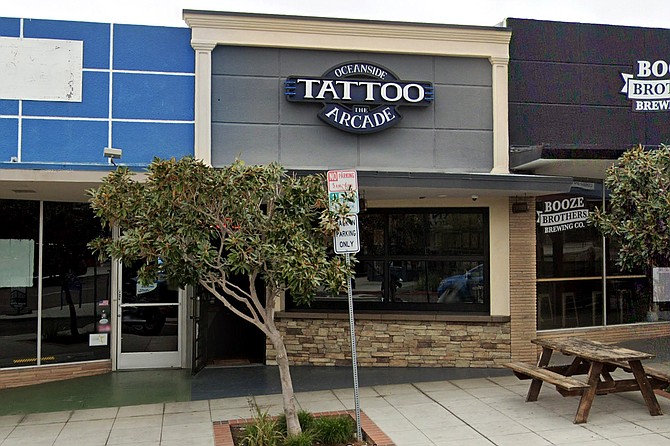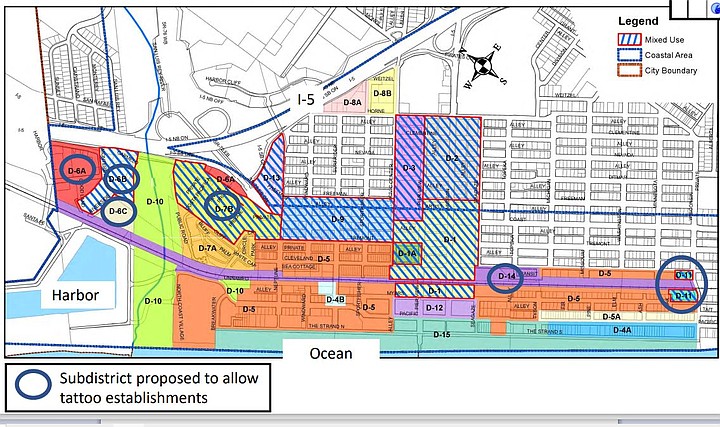 Facebook
Facebook
 X
X
 Instagram
Instagram
 TikTok
TikTok
 Youtube
Youtube

In Oceanside, like many cities, tattoo parlors have been nudged away from schools and neighborhoods. The city prohibits them within 500 feet of a residential district. As with cannabis outlets, they were long seen as doorways to crime. Until pot shops out-normalized them.
Cannabis businesses had to be at least 1,000 feet from residential districts but were allowed to seek location waivers from the city. Tattoo shops could not.
With all of the city's five licensed tattoo parlors located in commercial and industrial districts, there's been little room for newcomers since those zones tend to run along the main transportation corridors, which also border neighborhoods.

This week the California Coastal Commission will take up a zoning amendment the city has proposed to drop the distance requirement between tattoo shops and residential areas, as long as a freeway or state highway comes between the two uses.
"The city has determined that bisecting freeways provide a visual and sometimes physical barrier that is functionally equivalent to the 500-foot separation," a staff report reads.
A zoning ordinance amending the rules for tattoo shops was adopted by the city council on September 1, 2021, but a revision that expanded several commercial uses downtown was unintentionally left out of the local coastal plan amendment approved by the Commission in October, according to the report.
Once certified by the commission, the change will open up six new sub-districts downtown to tattoo businesses, to be approved by administrative regulated use permits.
Only one subdistrict at the eastern edge of Oceanside Harbor is next to coastal waters. The site allows retail sales, antique shops, wine and beer tasting, and overnight accommodations.
Of the 22 sub-districts currently within the downtown district, only two permit tattoo shops.
While historically body art shops were kept away from tourist areas, each of the six new subdistricts allow commercial or visitor-serving commercial uses.


In Oceanside, like many cities, tattoo parlors have been nudged away from schools and neighborhoods. The city prohibits them within 500 feet of a residential district. As with cannabis outlets, they were long seen as doorways to crime. Until pot shops out-normalized them.
Cannabis businesses had to be at least 1,000 feet from residential districts but were allowed to seek location waivers from the city. Tattoo shops could not.
With all of the city's five licensed tattoo parlors located in commercial and industrial districts, there's been little room for newcomers since those zones tend to run along the main transportation corridors, which also border neighborhoods.

This week the California Coastal Commission will take up a zoning amendment the city has proposed to drop the distance requirement between tattoo shops and residential areas, as long as a freeway or state highway comes between the two uses.
"The city has determined that bisecting freeways provide a visual and sometimes physical barrier that is functionally equivalent to the 500-foot separation," a staff report reads.
A zoning ordinance amending the rules for tattoo shops was adopted by the city council on September 1, 2021, but a revision that expanded several commercial uses downtown was unintentionally left out of the local coastal plan amendment approved by the Commission in October, according to the report.
Once certified by the commission, the change will open up six new sub-districts downtown to tattoo businesses, to be approved by administrative regulated use permits.
Only one subdistrict at the eastern edge of Oceanside Harbor is next to coastal waters. The site allows retail sales, antique shops, wine and beer tasting, and overnight accommodations.
Of the 22 sub-districts currently within the downtown district, only two permit tattoo shops.
While historically body art shops were kept away from tourist areas, each of the six new subdistricts allow commercial or visitor-serving commercial uses.
Comments